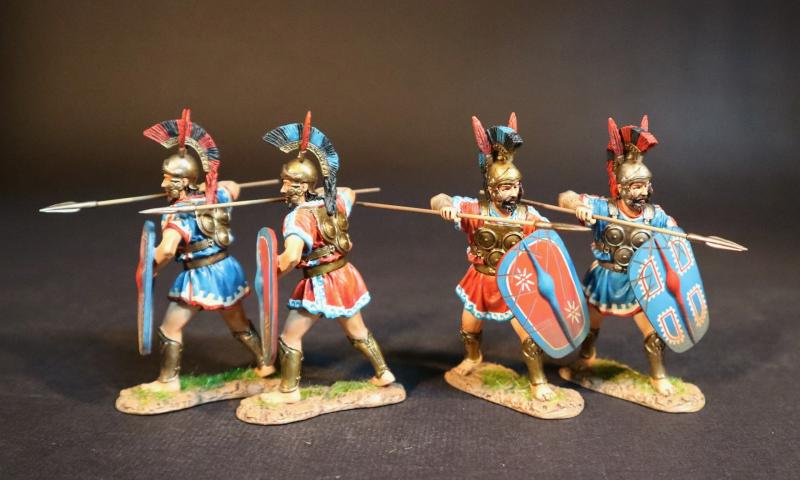Four Samnite Warriors (2 in red tunics, 2 in blue tunics), The Samnites, Armies and Enemies of Ancient Rome--four figures with spears pointed forward at shoulder height and shields
$215.00
Item Number: CTSM-02N
Four Samnite Warriors (2 in red tunics, 2 in blue tunics), The Samnites, Armies and Enemies of Ancient Rome--four figures with spears pointed forward at shoulder height and shields
ARMIES AND ENEMIES OF ANCIENT ROME
THE SAMNITES
The Samnites and their relatives in central and south Italy are known as Oscans, from the name of their language. The Samnites were the largest and most important Oscan nation, and was made up of a league of four tribes, the Pentri, Caudidi, Hirpini, and Caraceni.
The Samnites fought a series of wars with Rome from 343 to 272, and were by far Rome’s most formidable Italian foe. Many Samnites were later to join Hannibal.
Livy, the early Roman historian, states that the Samnites fought in a loose phalanx formation in the form of a square, which was tactically flexible and more suited to their hilly terrain.
The Greek style phalanx was a formidable weapon especially from the front. But it was not flexible, and once in contact with the enemy, was vulnerable on its unprotected flanks and rear. It also needed level, open terrain for its cohesion. The Romans had used the Phalanx to great effect along the coastal plains, but war in the constricted terrain of the mountainous spine of central Italy meant the Roman phalanx was a failiure. The Samnites did well in mobile warfare and were well used to mountain ambushes.
The Roman phalanx, with its advantage of brute strength, would probably defeat the Samnites on the level plain, but the Romans had to learn different tactics when confronted by the Samnites.
The large legion was, therefore, developed into three lines, with each line, in turn, broken up into small blocks capable of independent manoeuvre.
Samnite tunics were brightly coloured and decorated, and there is little evidence of uniformity.
Their weapons included the javelin and short spear. There was a mixture of oval and round shields, and many infantry wore a distinctive cuirasse of Italian design. Small breast and backplates of leather-backed bronze were linked by hinged straps of similar construction passing over the shoulders and under the arms. The commonest type was the triple disc style.
The proportion of cavalry fielded is never mentioned in historical references, but it is assumed it was low, as the wooded mountains would not have been good cavalry country. Like the Romans, the Samnite cavalry were organized into Turmae.
Many paintings show warriors carrying spears over their shoulders with bright cloths hanging from them. These are often interpreted as flags, but it is believed that they were tunics and belts. These represent trophies taken from the dead or captured enemy who had been stripped, which was a common practice in both Italy and Greece.
Released in AUGUST 2025.
